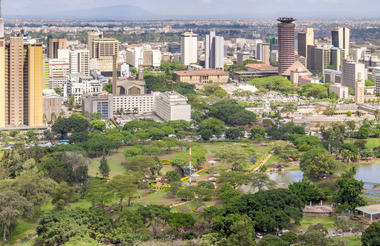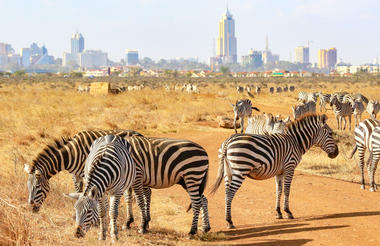When thoughts turn to safari, they turn immediately to Kenya. Books and movies such as Born Free and Out of Africa have brought this country’s offerings into the homesof many foreigners.
Kenya spans an area about 85 percent the size of France or Texas and lies astride the equator on the eastern coast of Africa, bordered by Uganda to the west, Tanzania to the south, Ethiopia to the north, Somalia to the northeast, and the Indian Ocean to the southeast. More than a century ago, Teddy Roosevelt let a brigade of hunters to Kenya in search of big game and today millions of international visitors follow his lead every year in capturing these same animals on film— and for good reason, considering the millions of large mammals in constant movement around Kenya’s plains. Kenya may be best known for its annual migration in the Masai Mara, Amboseli and Tsavo East and West National Parks are also emerging as some of the country’s greater tourist draws.
But Kenya is not all about big game. It is a land of timeless culture and unparalleled diversity, offering a wide range of options in landscapes and activities. Aided by a rich diversity of wildlife and its varied assortment of environments, all within relatively close proximity to one another, Kenya allows its visitors to experience endless opportunities for adventure every day. Indeed, a single trip to Kenya may include everything from climbing snow-capped mountains of the fertile highlands, such as Mount Kenya and Mount Meru , to exploring pristine wilderness, to visiting tropical forests, flat, parched, desert landscapes, long,pristine coastline with white, sandy beaches on the Indian Ocean, and rivers and lakes, including Lake Turkana —its largest lake — all within the borders of a single country, and Lake Victoria.
Kenya’s climate is generally warm and humid at the coast, cool and humid in the central highlands, and hot and dry in the north and east, and despite some newsworthy incidents, there seems to be no reason to consider Kenya unsafe as a tourist destination. In addition to everything else to do in Kenya, in 2001 the controversial “Millennium Man” was discovered near Lake Baringo in the northwest, and this find and Richard and Mary Leakey’s discovery of Homo Habilis in the 1960s continue to fuel ongoing excavations.
One of Kenya’s most iconic natural wonders, the Masai Mara National Reserve stretches across more than 1500 square kilometres in the country’s southwest. The park shelters a remarkable array of wildlife, including elephant, lion, leopard, and buffalo that roam its savannahs, while crocodile and hippopotamus inhabit the Mara River. Birdwatchers will delight in the presence of more than 450 resident species. Yet the true spectacle is the Great Migration, named one of the Seven New Wonders of the World. Each July to September, roughly 1.7 million wildebeest trek from the parched plains of Tanzania’s Serengeti to the greener grasslands of the Masai Mara, followed by zebra, antelope, and predators such as lion, hyena, and cheetah. The sight, sound, and raw energy of these vast herds are a once-in-a-lifetime experience for any traveller.
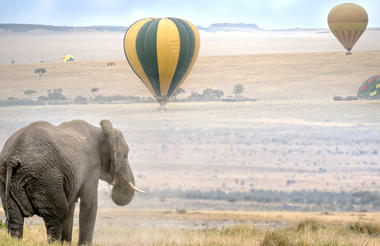
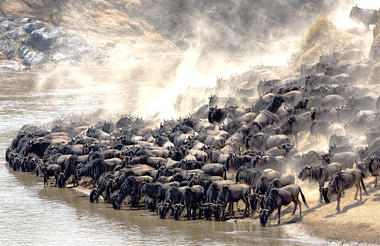
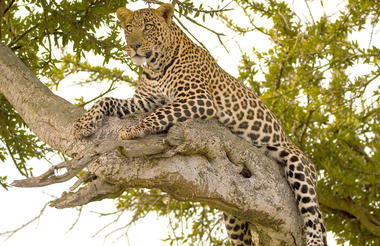
As previously described
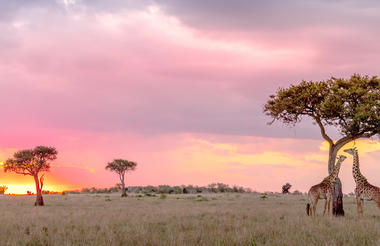
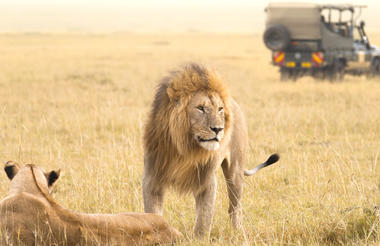
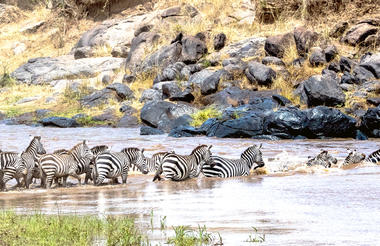
Rwanda is rapidly showing signs of development as it heals and rebuilds from the 1994 genocide experienced in the country. Today, the country is increasingly perceived internationally as a safe destination — indeed, tourism is one of the fastest growing sectors and is now the country’s leading foreign exchange earner. The Kigali Genocide Museum in Rwanda’s capital is well known and a must see for any traveler coming into this part of Africa
Rwanda is a small country, slightly smaller than Massachusetts and Maryland, or about half the size of Scotland, located near the center of Africa, and separated from the Democratic Republic of the Congo by Like Kivu and the Ruzizi River to the west; it is bounded on the north by Uganda, to the east by Tanzania, and to the south by Burundi. Grasslands and small farms extending over rolling hills, with areas of rugged mountains that extend southeast from a chain of volcanoes in the northwest, cover Rwanda’s countryside.
Rwanda is probably best known for its Mountain Gorilla treks in Volcanoes
National Park. A gorilla visit can entail anything from a 1 to 4 hour trek through the forest, led by experienced trackers who have spent their entire lives living in or close to the forest. Altogether less than 700 of the woolly black gorillas, first described by a German explorer a century ago and made famous by their murdered protector, American primatologist Diane Fossey,
survive in two small areas of cool mountain forest in Uganda and on the Rwanda-Congo border. On a continent where great apes are disappearing with dismaying speed to hunting and habitat loss, they are the rarest cousins in the family
The country known as the “Land of Thousand Hills” has amazing natural scenic beauty, unique flora and fauna in her three national parks. Visitors may enjoy a savanna ride and watch all the big five in Akagera Park, or embark on a primate’s discovery trip to track 13 types of primates including chimps and other types of primates in Nyungwe National Park — the largest block of high altitude montane forest in East or Central Africa, and one of the most ancient, dating back to before the last Ice Age. A uniquely rich center of floral diversity, the forest has more than 200 different types of tree, and a myriad of flowering plants including the other-worldly giant lobelia and a host of colorful orchids. Bird lovers will discover over 535 bird species of which 44 are endemic. For non-nature lovers, a 500-year-old cultural evolution awaits your discovery into the unique Rwandan folklore of traditional music, dancing, dressing, beautiful handicrafts, and this beautiful country’s well-preserved history in its museums.
Bordering the Democratic Republic of Congo in Rwanda, and set high on the jungle-covered slopes of the volcanic Virunga Mountains, the Volcanoes National Park is best known as a sanctuary for the region’s rare mountain gorillas. Visitors flock here to experience face to face encounters with these intriguing creatures. Regulated treks through the reserve allow visitors to spend an hour at a time with these incredible primates in their natural habitat. While the gorillas are without a doubt the main drawcard, visitors can also look forward to exploring a network of scenic hiking trails, with the beautiful day hike to the crater lake on Mount Bisoke being a particular highlight. Make sure to visit the fascinating Karisoke Research Centre and the tomb of the world-famous Dian Fossey.
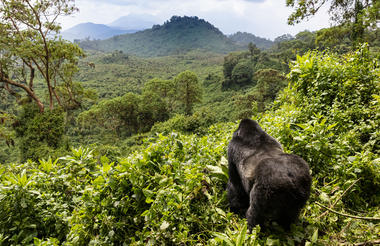
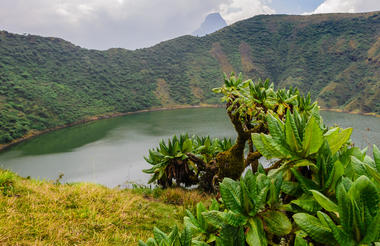
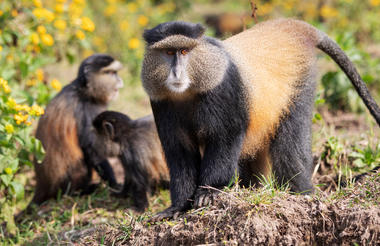
When thoughts turn to safari, they turn immediately to Kenya. Books and movies such as Born Free and Out of Africa have brought this country’s offerings into the homesof many foreigners.
Kenya spans an area about 85 percent the size of France or Texas and lies astride the equator on the eastern coast of Africa, bordered by Uganda to the west, Tanzania to the south, Ethiopia to the north, Somalia to the northeast, and the Indian Ocean to the southeast. More than a century ago, Teddy Roosevelt let a brigade of hunters to Kenya in search of big game and today millions of international visitors follow his lead every year in capturing these same animals on film— and for good reason, considering the millions of large mammals in constant movement around Kenya’s plains. Kenya may be best known for its annual migration in the Masai Mara, Amboseli and Tsavo East and West National Parks are also emerging as some of the country’s greater tourist draws.
But Kenya is not all about big game. It is a land of timeless culture and unparalleled diversity, offering a wide range of options in landscapes and activities. Aided by a rich diversity of wildlife and its varied assortment of environments, all within relatively close proximity to one another, Kenya allows its visitors to experience endless opportunities for adventure every day. Indeed, a single trip to Kenya may include everything from climbing snow-capped mountains of the fertile highlands, such as Mount Kenya and Mount Meru , to exploring pristine wilderness, to visiting tropical forests, flat, parched, desert landscapes, long,pristine coastline with white, sandy beaches on the Indian Ocean, and rivers and lakes, including Lake Turkana —its largest lake — all within the borders of a single country, and Lake Victoria.
Kenya’s climate is generally warm and humid at the coast, cool and humid in the central highlands, and hot and dry in the north and east, and despite some newsworthy incidents, there seems to be no reason to consider Kenya unsafe as a tourist destination. In addition to everything else to do in Kenya, in 2001 the controversial “Millennium Man” was discovered near Lake Baringo in the northwest, and this find and Richard and Mary Leakey’s discovery of Homo Habilis in the 1960s continue to fuel ongoing excavations.
Situated along the Nairobi River in beautiful Kenya, the capital of Nairobi is East Africa's most cosmopolitan city. It serves as an excellent starting point for African safari trips around Kenya. Nairobi is Africa’s 4th largest city and is a vibrant and exciting place to be. There are some fascinating attractions: its cafe culture, unbridled nightlife, the National Museum, the Karen Blixen Museum and most notably, just 20 minutes from the city centre, wild lions and buffalo roam in the world’s only urban game reserve. Make sure you pay a visit to the elephant orphanage operated by the David Sheldrick Wildlife Trust for a once in a lifetime experience.

